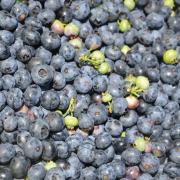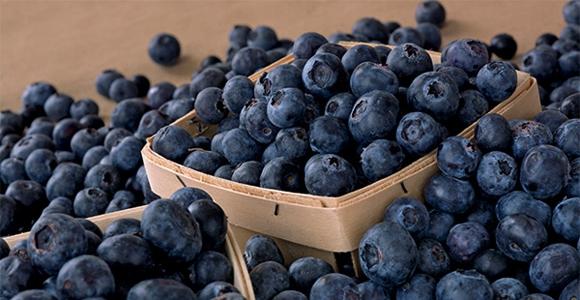In order to machine harvest a blueberry bush, several management considerations need to be made. Bed configuration is one of these. Raised beds bring catch plates closer to the base of the crown of the blueberry bush. Any suckers and low-hanging shoots should be removed from the lowest 14 inches of the plant and the crown must be kept narrow (Fig. 1) to minimize loss of fruit. Wide crowns result in excessive fruit loss when the berries hit the ground. Plant spacing is another important consideration. Between-row spacing should be a minimum of 9-10 feet. There also needs to be a minimum of 30 feet clearance at the end of the each row to allow equipment to turn around. Having period row break (e.g. every 400 ft) is suggested to help with managing harvest tasks such as unloading the harvester. In-row spacing of blueberry bushes should be a minimum of 3 feet, but exact spacing depends on the cultivar and site.

Each blueberry cultivar has characteristics that make it suitable, or not suitable, for mechanical harvest. A suitable cultivar should have the proper plant architecture, which includes good root anchorage, upright growth habit, narrow crown, and a canopy that is not too dense. Suitable cultivars also have an even, condensed maturity period. Fruit should have a small, dry stem scar with no stem retention and a low detachment force when the fruit is mature. Loose berry clusters are easier to harvest than tight clusters and fruit should be firm.
Many blueberries are still hand harvested because the quality of the fruit remains at its highest. There is little impact that machines cause if human hands collect the berries and the demand for blemish-free fruit in the fresh market is high. However, bushes must be harvested frequently (2-4 day intervals) and the labor supply is rapidly dwindling. Price points also decline as the season progresses making hand harvesting labor unprofitable. Therefore, mechanical harvest of blueberries is an expanding option for many blueberry growers for both fresh and process markets. Using machines to harvest for the fresh market is an area of great interest, but problems with packout losses due to too much immature fruit (Fig. 2), ground losses during harvest (Fig. 3), and fruit bruising are problems that currently restrict its use.


Even though mechanical harvest is currently available, there are several challenges that limit this type of harvest, including:
- Fruit missed by harvester that falls to the ground
- Harvest of immature fruit
- Missed mature fruit
- Fruit drop between harvests
- Fruit bruising
- Plant injury
The most common harvester machine type is the over-the-row harvester. The advantages of this type of harvester is that they can harvest a high capacity of fruit, reduce the need for labor, and minimizes the cost of harvest. They are expensive and may be cost prohibitive to medium and small-sized producers. Over-the-row harvesters also have other disadvantages. Because this type of harvester goes over the bush, berries fall quite a distance to the catch plates and can be bruised. Bruising significantly reduces shelf-life and may make berries unmarketable for the fresh market. Once berries are harvested they are dropped into lugs for transport, which can be another source of fruit bruising (Fig. 4). Unripe berries are also harvested at a greater rate than those that are hand harvested.

Other types of harvesters exist too, such as semi-mechanical harvest-assist platforms. These are less expensive than over-the-row harvesters and are used in concert with a shaking device. They are still in the evaluation stages but could soon bring another option to producers with medium or small operations.
Currently, the most common use of machine harvest in blueberries is for the process or frozen market. But, as technology improves, harvesting blueberries for the fresh market will become more commonplace.
Authors:
Eric Stafne, Mississippi State University
Jeff Williamson, University of Florida
